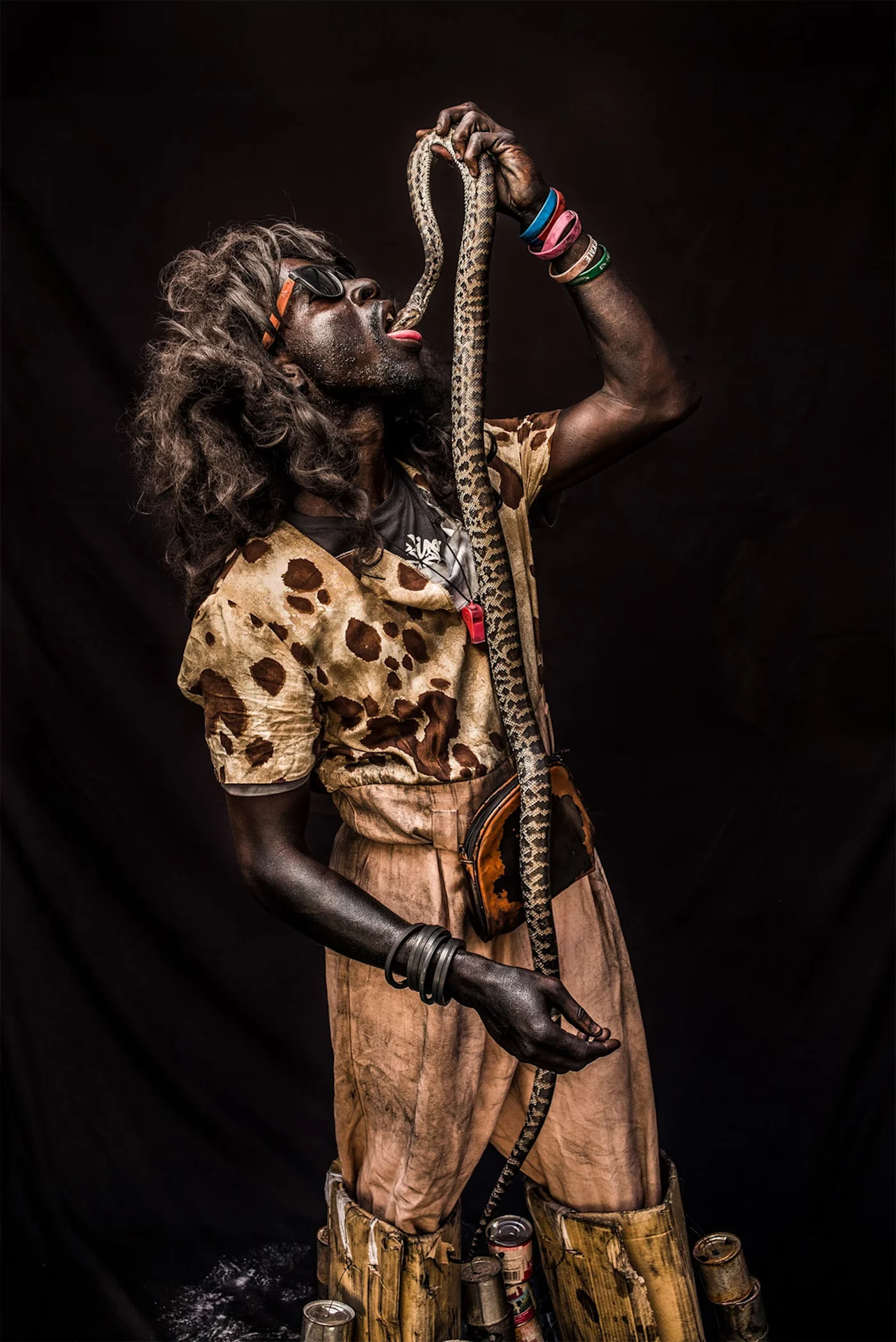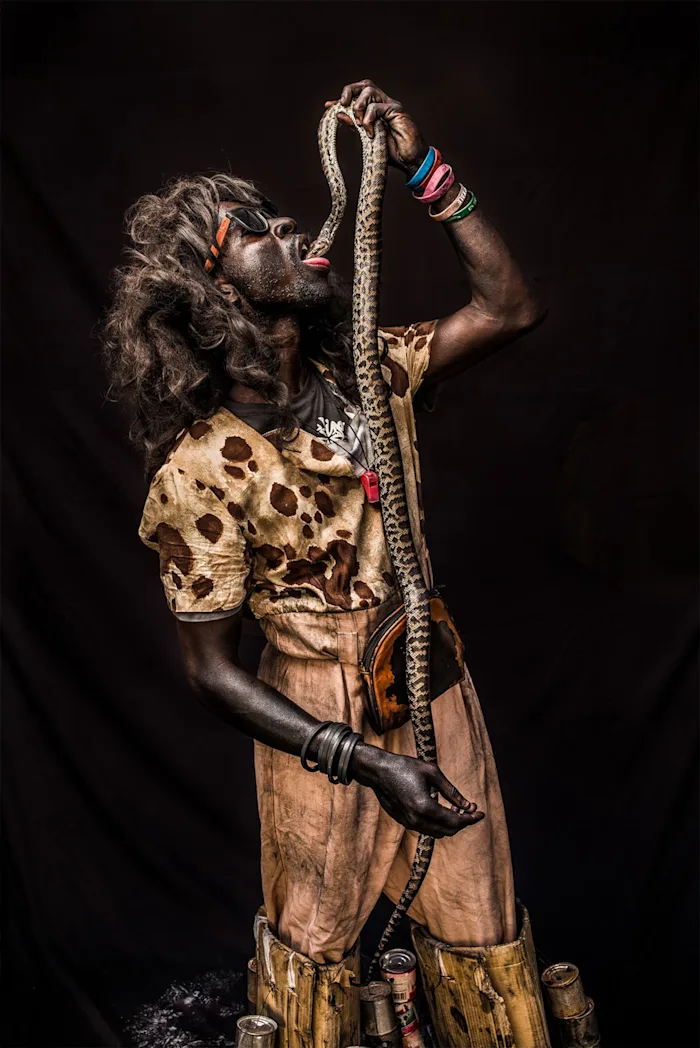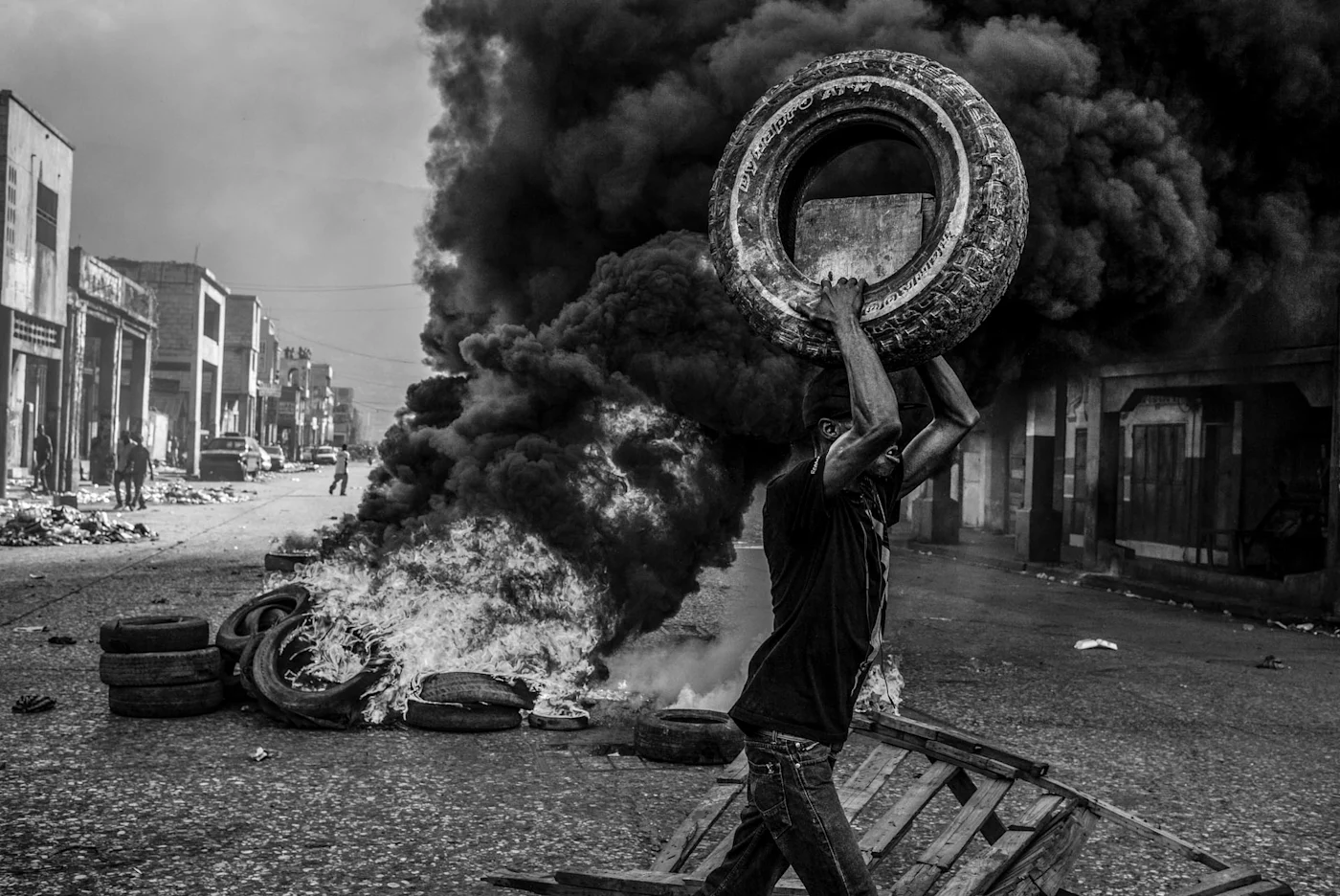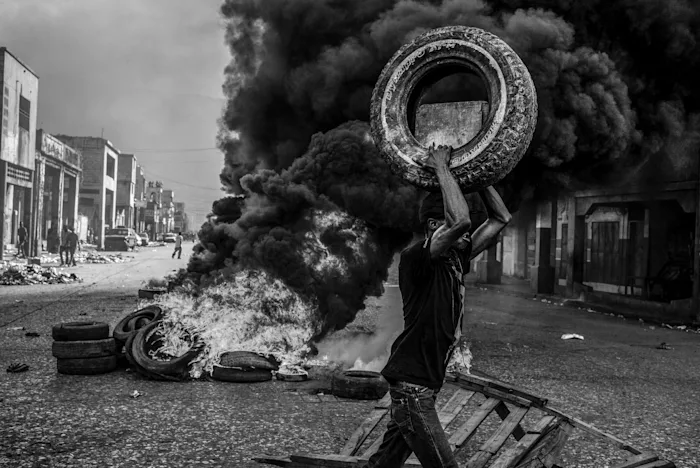Bring The Swords, Storm the Palaces:
A Partisans of Color Position
Haraami
In recent years, conversations among certain non-white and non-Western revolutionaries have been growing and deepening. We have encountered each other at gatherings, actions, workshops, assemblies, and the frontlines of insurrectionary upheavals, where we have begun to articulate our frustration with the existing political frameworks on offer for “people like us,” and expressed a desire for another language, another orientation. Over the last year, this process of encounter and articulation has been accelerated by panels1 and new writing, which have opened up new conversations and connections amongst those of us seeking to move beyond our current impasses. As these conversations have grown, we find that more and more people are drawn into them, finding something resonant which they have been waiting for. We — those of us who have been having these conversations in our own heads, amongst friends, in side conversations, phone calls, panel discussions, and written word — want to meet more fellow travelers and deepen our thinking, to begin forging another kind of politics together. To that end, the following intervention aims to more clearly articulate the situation we find ourselves in, and, most importantly, what it is that we hope to advance towards, together.
There is a void in existing non-white and non-western revolutionary thought in the United States. What has filled this void is BIPOC radicalism, a set of tendencies, patterns of acting and feeling, and ideologies which falsely claim to represent all non-white and western revolutionary perspectives.2 Contrary to its pretensions, this genre of radical politics in fact serves as a brake on revolutionary activity, above all on that of non-white people.
Existing BIPOC radicalisms oscillate between two poles: racial identitarianism and militant political identity.
The first pole, racial identitarianism, refers to a genre of “radical-liberal” politics: radical in its analysis and critique of race, the state, capital, nonprofits, etc., but ultimately liberal in practice. In these circles, revolutionary practices, and the messiness, complexity, and risk they entail, are sterilized and suppressed. Rather than accepting the risk of danger that a revolutionary movement demands, this tendency embraces a liberal politics of safety that erases and suppresses non-white militancy. At the same time, it rallies around reassuring fictions of an essentialized racial identity stripped of internal differences. If such fictions are needed, this is because they justify practices of “centering” specific identities presumed to be the most oppressed, while demanding deference from everyone else. The lived experience of the oppressed is reduced to a homogeneous abstraction from which a presumptively shared set of political desires is extracted. An underlying politics of scarcity and competition drives conflicts over who has the “right to speak” in political spaces, as if an individual’s politics were fully determined by their positionality.
Such radical liberalism reduces structural forces to a matter of one's overdetermined positionality, measuring an individual’s radicality by the ability to perform this positionality, to name their victimization. By contrast, a revolutionary perspective must recenter resistance, agency, and power, by insisting that white supremacy is a political force composed of institutions, infrastructures, and ways of being that can be destroyed and deactivated through collective revolutionary activity. By reducing politics to the management of interpersonal dynamics and decentering revolutionary agency, the slide towards trauma management produces endless negative cycles of people-pleasing, victimization, powerlessness, and conflict spirals among BIPOC and allies alike.


The second pole could be characterized as a non-white racialized militant political identity. While more engaged in militant and revolutionary practices, this tendency still remains trapped by limits of its own conception of racial and political identities (Anarchist, Communist, Escalationist, or otherwise). Political identities are construed as positions of ideological certainty and militant purity. One’s racialized identity is then constructed around one’s political identity, endowing the most quotidian opinions with lofty connotations of certainty and purity, and enabling easy moral judgements of real, complex events and of other revolutionaries on the basis of their supposed “failings.” Ideological and racial positions become closed-off castles whose walls must constantly be defended against impurity and foreign influence.
Such a simplified division of the world and of revolution is in fact an operation of capture and control, containing both within neat identitarian and political categories. Once this operation is complete, it is used to justify militant conflict escalation against other revolutionary tendencies, although rarely against our enemies in power — which in other eras might have been called wreckerism: personal conflicts are disguised as political critiques, and political differences misnamed as identitarian or moral conflicts. One’s militant position not only becomes the only true revolutionary position, but the only authentically non-white, decolonial, or anti-imperialist positionality. One’s position in a given debate comes to determine whether one is properly revolutionary or Anarchist, or else one is a White revolutionary/anarchist — and this, regardless of the actual identities, ideologies, or practices of each party to the conflict. Such dynamics eventually lead to these positions eating their own, as militants split and devour each other in iterative cycles of critique, until their own position finally collapses and they retreat into silence. This is ultimately an operation of what Montgomery and bergman have dubbed “rigid radicalism,”3 an attitude that approaches complex situations through a paranoid lens, hyper-vigilant for limitations, failures, and disappointments, and so inevitably produces them, while erasing opportunities and possibilities that lie latent.
Defining one's positions through a politics of critique reinforces distance from the messy complexity of a situation, justifying disengagement from impure revolutionary processes and absolving one of the responsibility of developing a positive vision and power from within that complexity — something which these positions have ultimately abandoned in favor of ideological or tactical fetishism. In a recent article, Athena describes this position as a politics of sacrifice, wherein gestures that might otherwise grow our collective powers in ideologically or morally impure ways are treated as betrayals of an implicit radical culture of shame and defeat, one which fetishizes our position of marginality and dooms us to always remain impotent critics and “beautiful losers.”4
Both of these poles share an underlying logic and structure of feeling. Guilt, shame, and anxiety about one’s position in the world leads to a constant search for the germs of oppressive power in oneself, ultimately suppressing the very sense of power that would liberate us from racial subjugation. The policing of racial lines to determine who is qualified to speak reproduces the logic of race science, and de facto centers American experiences of race. Using identitarian lines to impose rigid ideas about one’s role in the revolutionary process — both “white people to the front” and “white people must organize white people” — actually stifles the creative process of insurgency, and ultimately articulates all politics in relation to whiteness itself.
We operate with a different generational experience of race, identity, and struggle. Class and political contradictions within racial identities have produced deep fractures. Even the fragmentation among political identities like “anarchist,” “communist,” “liberationist,” means that simply describing oneself as a “non-white anarchist” tells us little about one’s real orientation to strategic and political questions. To paraphrase Palestinian revolutionary martyr Basel Al-Araj, the world is split into a colonial camp and a liberation camp, and one can find people of all nations, skin colors, and identities on both sides. In this context, we have seen that the formal organizations and leadership that once formed the militant edge of revolutionary struggle among the colonized no longer occupy that position in the face of the insurrectionary sequences of the last decades, which have defined our generation. These insurrections proceed in the absence of formal mass organizations leading them, developing new paradigms and new limits that we must grapple with. In these situations, the factions that previously would have represented non-white revolutionary leadership have at best either proven themselves irrelevant and been left behind, or at worst have acted as counter-insurgent forces of suppression when insurrectionary events outstrip their control.5 In this context, calls to follow the “leadership” of a particular oppressed group, coming from liberals and revolutionaries alike, ring hollow. Part of this is due to an attachment to paradigms that have reached their limits, such as nationalism, sovereignty, and centralism. Such paradigms are an inheritance we must break with, for they themselves became an obstacle to the revolutionary horizons of the 20th century and birthed the modern monsters of multipolar imperialism, post-colonial bourgeoisies, and transnational capital that we face today.


One of the most important lessons of this epoch’s insurrectionary cycle is that there is no singular revolutionary subject, no singular revolutionary struggle that can be conceived in isolation. Insurrections develop precisely when they cut across and involve multiple social categories, including members of the socially dominant group. They reach their limits precisely when those divisions are reinstated, whether from above or from within the movement.6 Revolution, therefore, cannot be solely focused on the activity of any one dominated position, but must be able to think and act across many. Advancing the struggles of the racially oppressed towards revolutionary horizons will require that non-white and non-western revolutionaries strategize around how potentially millions of white people might participate in such a revolutionary process — and this, in spite of their frequent disdain expressed for doing so.
In the US in particular, our generational moment is in part defined by the horizons opened by the fragmentation of whiteness itself: as the reorganization of governance and economy pulls back the wages of whiteness, this opens opportunities for political realignment among fractions of white people. We cannot afford to ignore these openings on a moral or ideological basis. We must seize the opportunity to fuse these fragments into a revolutionary decolonial communist horizon, rather than a monstrous 21st century fascist one.
In the wake of these generational experiences, and despite its constant erasure by activists and revolutionaries of all colors, a qualitatively different non-white militancy has been developing.7 This militancy cannot be identified purely by the quantitative racial composition of a particular space, network, or movement, but is recognizable by a particular intensity of thought, action, and ethical attunement to insurrectionary situations.
We want to bring about the BIPOCalypse — to explode the limits of our current discourse on race and forge a partisans of color8 fraction. Such a force must be oriented by a fidelity to the messy, multiple, unholy alliances and material processes that revolution will require, which will (importantly) exceed our control, overflowing our neat moral categories. It will require the building of our own impure powers, and will necessarily, especially in this country, need to involve millions of white people who currently make up the numerical majority. This revolutionary process does not aim to reinforce racial categories but to abolish a society that produces race, and in this process open new horizons of relation, kinship, comradeship, and interdependence.
We seek, and find ourselves drawn to, revolutionary networks in which something more vibrant and powerful than the suppressing force of BIPOC radicalism flourishes. We sense this vibrancy manifested in an orientation toward curiosity and experimentation in relation to insurrectionary processes, which takes seriously the commitment to building power through real moments of struggle. We feel our powers growing in places where strategic, creative, deep thinking challenges and refines our ideas beyond the confines of ideological or moralistic certainties, enabling a multiplicity of political positions to challenge each other in their movement towards shared horizons. Such places cultivate the ability to build commonality across difference and resilience in the face of conflict, which enables some level of persistence, memory, and ethical attunement. This demands an ability to move beyond rigid identitarian lines and their anxieties and reach towards common notions that cut and connect across differences without canceling heterogeneity. In sum, we are drawn to organizing that prioritizes the construction of a warrior culture, the weaving of interdependent networks of kinship and relationality, in search of dignified lives in common. Ultimately, we desire to orient beyond our current position or subjection in this world and towards our desires, towards other potentials and ways of being together that are opened by revolutionary activity, towards what we might become through the process of struggle.


Such an orientation stands starkly opposed to the Partisans of Control who seek to capture revolution within identitarian and ideological cages, whether reactionary, radical liberal, activist, militant, or otherwise. We believe in developing militancy both qualitatively and quantitatively: we want a force capable of organizing spaces and encounters that will transform organizations, networks, and people engaged in them. While we should not moralistically close ourselves off the possibility that white people can do this, we must not abdicate our agency by relying on them to do it for us, but find each other to begin building this pole.
Efforts to build this pole exist. This year saw the launch of The Peoples Want, an internationalist formation born out of the same generational experience of insurrection. Their manifesto grapples with many of the necessary questions that all partisans must confront concerning the limits of struggles, organizational dilemmas, and the material needs of a revolutionary process. All this is informed by a global set of perspectives on the 21st century sequence of struggles informed by encounters between participants from the global south, as well as insurrectionary anarchists and communists:
In revolt, we have regained our dignity. From continent to continent, from our exile, in our travels and in our struggles, we have found each other. In the clash of street battles, gestures seen and then replicated in different countries, words echoed across languages, we have recognized each other. We understood that we belong to a single transnational struggle and that we stand against an internationally organized elite. We know that if we remain isolated, we will achieve nothing. The bitterness of our defeats, and our refusal to accept them as final, has engendered the desire to get to know each other. We have begun to weave a network of planetary connections, from front lines to popular assemblies, from feminist strikes to resistance committees, from occupied traffic circles to occupied forests, and have discovered a common sensibility.9
We partisans of color must learn from and engage with such internationalist conversations around questions of revolution, and understand that combating the limitations of BIPOC radicalism is necessary to challenge the US-centrism of our racial dialogue and the Amer-identitarianism of our politics. Importantly, identity politics has become an export of the American Empire, an export which turns potentially insurgent forces into diverse populations to be represented, negotiated with, and captured. This fomenting of identitarianism stifles the growth of common revolutionary horizons across the globe. As comrades across the globe look to us in developing thought and strategy to combat the influence of this export, we must understand that our task in forming this partisan pole is global in scope.
I’d like to conclude by posing some questions that might orient the coming partisanship of color.
First, how does our responsibility to the past align with our orientation towards the future? Many of us come from places and peoples intertwined with rich lineages of struggle and creative revolutionary thought, including lineages that have been erased by the nationalist and authoritarian narratives of the 20th century revolutionary cycles. What are these lineages? What resources, skills, and weapons do we bring to the war against this world? How do we build upon, innovate within, and also break with our revolutionary traditions, even the non-white or BIPOC ones? Those of us who draw on these lineages while orienting ourselves towards our generational moment bring something powerful to the table, capable of reinvigorating, remixing, and even breaking with tradition. On the other hand, we must resist the impetus to freeze traditions in time, and instead remember that transformation, rupture, and mutation are as integral to the development of a lineage as inheritance. Many lineages, especially revolutionary ones, are themselves born of such breaks or mutations from previous traditions, and are continuously reshaped from within and through encounters with other lineages. While it is true, as Sophie Lewis observes, that it can be “existentially petrifying to imagine relinquishing the organized poverty we have in favor of an abundance we have never known and have yet to organize,”10 we cannot inherit that which we have not yet become. This can only be won through a leap into the unknown.
Next, from the position we stand in, which other tendencies do we resonate with? How do we build on this? What do we each do, and what do we want? How do we develop a shared language for describing what limits us and what we aspire towards? What sorts of common notions11 would support the proliferation of partisanship and insurrection, enabling us to speak and act across our differences? Do we agree? What is missing?


A revolution will have to cut across all identities, while reshaping these identities themselves. No matter how revolutionary we believe any particular struggle is, the fact is that none of us can win alone. Finally, then: What do partisans of color bring to this process? How do we compose with others, while transforming this process and ourselves along with it? How do we rewrite identity beyond the ones ascribed onto us, in order to emphasize our practices, desires, and subjectivity rather than our subjugation? How do we connect the threads of particular struggles into a mutually intelligible revolutionary project that transcends any single political category, without falling back upon empty abstractions? What role do we have to play in the revolutionary liberation of billions of people across the world?
The world — this is the scale at which we must orient, and not simply our personal feelings and friendships, insular milieus, spaces, and organizations. We must avoid the temptation to retreat into insularity, or to hyperfocus on particular struggles. Instead, we must orient ourselves to the many horizons of revolution — horizons spanning across the globe, into the depths of the earth and ocean, the stars and cosmos, our selves and spirits, our pasts and futures.
July 2025
Images: Corentin Fohlen
Notes
1. For example, see “Identity Politics in Radical Movements,” It’s Hot in Here With Silver Lining (podcast), June 13, 2024. Online here.↰
2. Our use of this term builds upon the analysis previously set forth in Haraami, “Follow the Fires,” in Living and Fighting, vol. 2 (online here): “BIPOC radicalism is not synonymous with any non-white radicalism, radicalisms that take seriously the question of race at political, strategic, personal, and communal levels, or radicalisms drawing on non-Western ways of being and lineages of resistance. It names a particular mix of elements of identitarian politics--essentialism, a rhetoric of safety and vulnerability, and a politics of deference--with tendencies of more rigid radicalisms--moralism, destructive critique, internal policing, and the formation of enclosed milieus bound by an insular shared language.”↰
3. As Montgomery and bergman describe this phenomenon: “It is the pleasure of feeling more radical than others and the worry about not being radical enough; the sad comfort of sorting unfolding events into dead categories; the vigilant apprehension of errors and complicities in oneself and others; the anxious posturing on social media with the highs of being liked and the lows of being ignored; the suspicion and resentment felt in the presence of something new; the way curiosity feels naive and condescension feels right”; and “Rigid radicalism is both a fixed way of being and a way of fixing. It fixes in the sense of attempting to repair, seeing emergent movements as inherently flawed. To fix is to see lack everywhere and treat struggles and projects as broken and insufficient. It also fixes in the sense of fastening or making permanent, converting fluid practices into set ways of being, stagnating their transformative potential.” Montgomery and bergman, Joyful Militancy, AK Press, 2017, 168-169. [An excerpt is online here. —Ed.]↰
4. Athena, “Addicted to Losing,” Ill Will, March 14, 2024 (online here): “More generally, efforts of radicals to increase their power of acting, whether through acquiring spaces like houses and social centers, money for bail funds and projects, or even forming larger strategies about how to defeat the police in the streets are treated as a violation of an implicit set of values that venerates the experience of being trapped. These tactics are seen by some radicals as a dangerous ploy for power, which risk being reigned back into domination...Revolutions take strength. Deactivating that which governs us takes strength. We should want that power and should shamelessly seek it, rather than smothering it beneath the specious garb of asceticism. This shame that blocks us is rooted in what Nietzsche calls ressentiment, an envy felt toward another whom we believe to be the sole cause of our lack of power. Ressentiment is what leads radicals to police attempts at freedom that lie outside of their preferred grammar of conflict, which they wrongly interpret as the reason the enemy keeps winning...Shame seeps into our bodies, to the point where we learn to see ourselves as little else than instruments of domination, until our own self-destruction becomes a moral duty. In this way, the suicidal despair that this world proliferates is thereby transmuted into a radical consciousness.” ↰
5. For example, see Shemon, "Missed Insurrections" (online here), and J. Sakai, “Blackstone Rangers: A U.S. Experiment Using ‘Gangs’ to Repress Black Community Rebellion” (online here).↰
6. On this point, see Endnotes, “Spontaneity, Mediation, Rupture” (online here) and The Peoples Want, Revolutions of Our Times: Internationalist Manifesto, 2024, 16-20 (online here): “A revolt is limited when those who trigger it fail to rally other types of anger. Facing the centres, the great architects of our separation, the challenge of our uprisings was to ensure our encounter. Encounters between different segments of the margins, but also encounters between those on the margins and dissidents from the centres; those who defy the powers from which they benefit, such as the inhabitants of colonial metropolises who support liberation struggles in the colonies. Where a segment of the margins, such as peasants in India, indigenous people in Ecuador, high school students in Chile or black people in the United States, was joined by a large part of the population, uprisings have managed to achieve victories."↰
7. The erasure of this militancy is partly made possible by the fact that some of us are only just beginning to find each other on our own terms, beyond the limits of BIPOC radicalisms.↰
8. Partisan here refers to an orientation towards taking a position within the upheavals of our era and committing to building power and capacity amidst crisis, for expanding rupture, and advancing insurrectionary, anarchic, communist horizons, something irreducible to an ideological position. Partisans of color is an attempt to articulate this orientation in relation to non-white & non-Western revolutionaries struggling against both the racial order which subjugates us and the racial identities which subjectify us. It must ultimately become a negation of its own ground, of the racial identity upon which it stands, in order to draw lines of affinity, understanding, and common orientations towards international revolutionary horizons.↰
9. The Peoples Want, Revolutions of Our Times, 12-13↰
10. Sophie Lewis, Abolish the Family, Verso, 2022, 9. ↰
11. “Common notions are not fixed ideas but shared thinking-feeling-doings that support joyful transformation. As such they require uncertainty, experimentation, and flexibility amid changing circumstances, and they exist in tension with fixed systems of morality and ideology … [They are] processes through which people figure things out together...learning to participate in and sustain new capacities.” Montgomery and bergman, Joyful Militancy, 169, 279. ↰